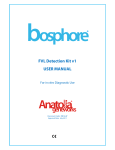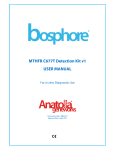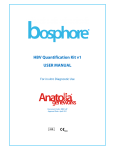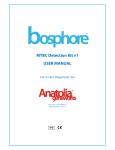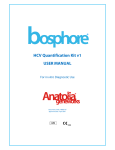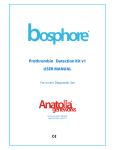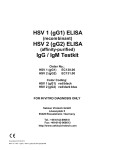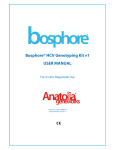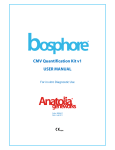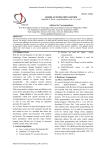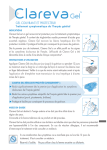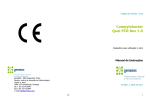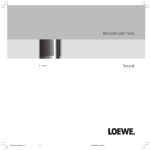Download HSV 1-2 Genotyping Kit v1 USER MANUAL
Transcript
® HSV 1-2 Genotyping Kit v1 USER MANUAL For in vitro Diagnostic Use ® Document Code: MB17v2f Approval Date: April 2011 Contents Page 1. Product Description 1 2. Content 1 3. Storage 1 4. Required Materials and Devices 1 5. Important Notes and Safety Instructions 2 6. Product Use Limitations 2 7. Pathogen 2 8. Method 3 9. Procedure 4 9.1. Sample Preparation, Storage and Transport 4 9.2. DNA Isolation 4 9.3. Kit Components 4 9.3.1. PCR Mix 4 9.3.2. Detection Mix 4 9.3.3. Positive Control1 5 9.3.4. Positive Control 2 5 9.4. Preparing the PCR 5 9.5. Programming the Montania® 483 Real-Time PCR Instrument 5 10. Analysis 7 11. Troubleshooting 9 12. Specifications 9 12.1.Sensitivity 9 12.2.Cross-Reactivity 10 13. References 10 14. Symbols 10 15. Contact Information 11 ii 1. PRODUCT DESCRIPTION Bosphore® HSV 1-2 Genotyping Kit v1 detects and distinguishes Herpes Simplex Virus 1 and 2 in human biological samples. The analytic sensitivity is 1500 copies/ml for HSV1, and 1250 copies/ml for HSV2. A region within the Glycoprotein D gene within the HSV1 genome is amplified and fluorescence detection is accomplished using the FAM filter. A region within the Glycoprotein D gene within the HSV2 genome is amplified and fluorescence detection is accomplished using the Cy5 filter. 2. CONTENT Bosphore® HSV 1-2 Genotyping Kit v1 components have been listed below: Component 1 2 3 4 5 REAGENT dH2O PCR Mix Detection Mix Positive Control 1 (HSV1) Positive Control 2 (HSV2) 100 Tests (1000 µl) (1375 µl) (180 µl) (88 µl) (88 µl) 50 Tests 25 Tests (1000 µl) (688 µl) (90 µl) (44 µl) (44 µl) (1000 µl) (344 µl) (45 µl) (22 µl) (22 µl) 3. STORAGE Bosphore® HSV 1-2 Genotyping Kit v1 PCR reagents should be stored at -20°C. Repeated thawing and freezing (>3x) should be avoided since it may reduce sensitivity. If the components are to be used in small amounts, they should be frozen in aliquots. While preparing the PCR; the components should not be exposed to room temperature for more than 10 min. and the detection mix components should not be exposed to light more than 1-2 min. We recommend preparing the PCR on a cooling block and keeping the detection mixes within a closed container. The components maintain their stability until the expiry dates on the labels, if they are stored at advised conditions. 4. REQUIRED MATERIALS AND DEVICES • Montania® 483 Real-Time PCR Instrument (Anatolia Geneworks), or another Real-Time PCR system with FAM and Cy5 filters (iCycler, iQ5, CFX–BioRad, LightCycler 1.5, 2.0, 480-Roche, 7500 Real-Time PCR System-ABI, Stratagene Mx3005P, Mx3000P-Agilent, LineGeneK, LineGene 9600-Bioer, Rotorgene 2000, 3000, 6000, Q-Qiagen) • 0.2 ml Thin-Wall PCR tubes or strips • Magnesia® 16 Nucleic Acid Extraction System / Magnesia® Viral Nucleic Acid Extraction Kit (Anatolia Geneworks), or other high quality viral DNA extraction kits and systems • Deep freezer (-20°C) • Desktop centrifuge with rotor for 2 ml. microcentrifuge tubes Document Code: MB17v2f Date: April 2011 1 • Calibrated adjustable micropipettes • DNAse, RNAse, pyrogen free micropipette tips with filters • DNAse, RNAse, pyrogen free 1.5 or 2 ml. microcentrifuge tubes • Disposable laboratory gloves 5. IMPORTANT NOTES AND SAFETY INSTRUCTIONS Important!: • The product should be delivered on dry ice. Check for presence of dry ice upon arrival. • Check for the expiry dates on the box and tube labels, upon arrival. Do not use expired products or components. • Calibrated or verified micropipettes, DNAse, RNAse, pyrogen free micropipette tips with filters, and DNAse, RNAse, pyrogen free microcentrifuge tubes should be used. • Before starting a test procedure, all components should be thoroughly thawed. After thawing, all components should be centrifuged briefly (spin-down for 3-5 seconds), and mixed well to ensure homogeneity prior to use. • The kit components should be kept on ice or a cooling block until the reaction is prepared, and they should be quickly returned to -20ºC. • PCR and nucleic acid isolation must be performed in different compartments. Samples should be stored separately to avoid contact with the kit components. • Pathogen information should be reviewed to be aware of the health related risks. • Biological samples should be handled with extreme caution, suitable class microbiological safety cabinet should be used: Physical contact with pathogens should be avoided by; wearing lab coats and gloves, no allowance for eating or drinking within the workspace, prevention of unauthorized individuals’ access to the working area. • All the pathogenic wastes produced during the nucleic acid isolation step; including the serum samples and material contacted with them, should be discarded into medical waste and disposed safely. 6. PRODUCT USE LIMITATIONS • All the components may exclusively be used for in vitro diagnostics. • This product should be used in accordance with this user manual. • This product is to be used by personnel specially trained to perform in vitro diagnostic procedures. 7. PATHOGEN Causative Agents Herpes simplex viruses (HSV), a member of Herpesviridae, are complex (containing ~35 virion Code: MB17v2f Date: April 2011 2 proteins) DNA viruses, 180-250nm in size, with genomes up to 235kbp DNA. İnfections caused by two types of HSV (HSV-1, HSV-2) are very common worldwide. Herpes simplex virus type 1 (HSV-1) primarily causes face, eye, mouth, throat, and CNS-central nervous system- infections while HSV-2 is the main causative agent of genital herpes. [1] Epidemiology Herpes simplex virus (HSV) infection is one of the most common viral infection with worldwide rates of 65% to 90%. Large differences in HSV-1 and HSV-2 seroprevalence are determined across the Europe, HSV-1 seroprevalence is high in Bulgaria and Czech Republic and lower in Belgium, Netherlands and Finland. Young adults in Northern European countries are less likely to be infected with HSV-1. HSV-2 seropositivity is widely distributed in Europeans older than 12. Bulgaria has a high incidence relative to other European countries such as Germany, Finland, Belgium, Netherlands. [2] Modes of Transmission HSV is spread by contact, as the virus is shed in saliva, tears, genital and other secretions, by far the most common form of infection due to a kiss given to a child or adult from a person shedding the virus. While HSV-1 is usually transmitted orally during childhood, HSV-2 is primarily a sexually transmitted infection bu both may be transmitted vertically during childbirth. The risk of infection to a non-immune individual in contact with contaminated secretions can be as high as 80%. Even though most of the people infected with HSV develop labial or genital lesions, the majority are either undiagnosed or without physical symptoms and thus considered at high risk for spreading HSV as they are unaware of their infection. [3], [4] 8. METHOD Bosphore® HSV 1-2 Genotyping Kit v1 is based on the Real-Time PCR method. Polymerase chain reaction is a technique that is used for amplification of a DNA region. The reaction occurs by the repeating cycles of heating and cooling. The main components of PCR are primers, dNTPs, Taq polymerase enzyme, buffer solution and template. As a brief explanation, primers are small synthetic DNA those anneal to the specific regions of the template in order to start the synthesis. dNTPs are the building blocks of the amplified products. Taq polymerase amplifies the DNA template. Buffer solution provides the pH adjustment required for the reaction and template, as referred, is the target region for synthesis. In Real Time PCR technique, in contrast to conventional PCR, PCR product can be monitored during the reaction. Therefore Real-Time PCR obviates the need for further analysis methods like gel electrophoresis, whereby minimizing the risk of contamination. Dual labeled probes employed in the reaction in addition to the conventional PCR reagents, enable detection of the amplified target with increased sensitivity. The assay utilizes the 5’ exonuclease activity of Taq Polymerase to cleave a dual-labeled fluorescent probe during the extension phase of PCR. The probe is labeled at the 5’ end with a fluorescent ‘reporter’ Code: MB17v2f Date: April 2011 3 molecule, and at the 3’end with another fluorescent molecule that acts as a ‘quencher’ for the ‘reporter’. When the two fluorophores are in close proximity, and the reporter is excited by light, no reporter fluorescence can be detected. During the elongation step of PCR, Taq Polymerase encounters and cleaves the probe bound to the template. As the reporter is freed from the suppressing effect of the quencher, fluorescence signal can be detected. The fluorescence generated by the reporter increases as the PCR product is accumulated; the point at which the signal rises above background level and becomes distinguishable, is called the threshold cycle (CT). There is a linear relationship between the log of the starting amount of a template and its threshold cycle, thus starting amount of unknown templates can be determined using standard curves constructed using CT values of the known starting amounts of target templates. Bosphore HSV 1-2 Genotyping Kit v1 employs multiplex PCR, HSV1 DNA and HSV2 DNA are coamplified in a single reaction, using sequence-specific primers and probes. The fluorescent signal generated by the HSV1 amplification is detected by a probe labeled at the 3’ end with FAM, through the FAM channel. The fluorescent signal generated by the HSV2 amplification, is detected by a second probe (labeled at the 5’ end with a different reporter molecule, Cy5) through the Cy5 channel. 9. PROCEDURE 9.1. Sample Preparation, Storage and Transport To isolate serum from the clinical specimen, the blood sample should be collected into sterile vacutainers without any anticoagulant. For venipuncture, only sterile material should be used. The serum should be separated from blood within 6 hours after blood collection. To separate the serum, the blood container should be centrifuged at 800-1600 x g for 20 minutes. The separated serum should be transferred to polypropylene tubes and stored at -20ºC or lower, until use. Samples should be transported in containers with capacity to resist pressure. Transportation should be done according to local and national regulations for pathogen material transport. 9.2. DNA Isolation We recommend that the Magnesia® 16 Nucleic Acid Extraction System / Magnesia® Viral Nucleic Acid Extraction Kit (Anatolia Geneworks) isolation system is used with Bosphore® HSV 1-2 Genotyping Kit v1. The DNA isolation should be performed according to the manufacturers’ instructions. The starting volume is 400 µl, the elution volume is 60 µl. Alternatively other high quality DNA extraction kits/systems can be used according to the manufacturers’ instructions. The kit type used should be chosen considering the type of the biological sample. 9.3. Kit Components 9.3.1. PCR Mix HotStarTaq DNA Polymerase: HotStarTaq DNA Polymerase is a modified form of a recombinant 94 kDa DNA polymerase, originally isolated from Thermus aquaticus, cloned into E.Coli. The enzyme is Code: MB17v2f Date: April 2011 4 provided in an inactive form. It is activated by a 15-minute 95 ºC incubation step. This prevents the formation of misprimed products and primer-dimers during reaction setup and the first denaturation step, leading to high PCR specificity and accurate quantification. PCR Buffer: contains Tris-Cl, KCl, (NH4)2SO4, 8 mM MgCl2, pH 8.7 (20ºC ). dNTP Mix: Contains ultrapure quality dATP, dGTP, dCTP ve dTTP/dUTP. 9.3.2. Detection Mix 1 Detection Mix 1 contains HSV1-specific forward and reverse primers and a dual-labeled probe , and HSV2-specific forward and reverse primers and a dual-labeled probe. 9.3.3. Positive Control 1 Positive Control 1 contains HSV2 DNA. It must be included in the PCR to test the efficiency of the PCR exclusively. The threshold cycle for the positive control is given in the acceptance criteria in the Analysis Section. Threshold cycles higher than the acceptance criteria may indicate an efficiency loss in the reaction. 9.3.4. Positive Control 2 Positive Control 2 contains HSV2 DNA. It must be included in the PCR to test the efficiency of the PCR exclusively. The threshold cycle for the positive control is given in the acceptance criteria in the Analysis Section. Threshold cycles higher than the acceptance criteria may indicate an efficiency loss in the reaction. 9.4. Preparing the PCR All four external quantitation standards should be added into the PCR reaction together with the samples and the negative control (PCR-grade water). Make sure that all the kit components are thawed before use. Refer to the table below for preparing the PCR. It is for only one reaction, multiply these values with the sample number to find the values required for the master mix. While preparing master mixes for more than 3 samples, an extra 10% should be added to the total sample number. PCR Mix Detection Mix 1 dH2O Sample DNA, Negative/Positive Control 12.5 µl 1.64 µl 0.86 µl Total Volume 25.0 µl 10.0 µl Pipette 15 µl of the master mix into the PCR tubes or strips, and add 10 µl of DNA (sample/positive or negative control). Close the tube cap. Make sure that the solution in each tube is at the bottom of the tube. Centrifuge if necessary. Code: MB17v2f Date: April 2011 5 9.5. Programming the Montania® 483 Real-Time PCR Instrument The thermal protocol for Bosphore® HSV 1-2 Genotyping Kit v1 is composed of an initial denaturation for activation the HotStarTaq DNA Polymerase, a two-step amplification cycle and a terminal hold. The real-time data is collected at the second step of the amplification cycle. Initial denaturation Denaturation Annealing and Synthesis (Data Collection) Hold 95°C 97°C 60°C 14:30 min. 00:30 min. 01:30 min. 22°C 05:00 min. 50 cycles Montania® 483 Real-Time PCR Instrument is installed and calibrated as it is delivered to the end user. In order to establish an appropriate link between the system components, first the thermal cycler and the optical module, and then the PC and the software should be started. Before starting a Real-Time PCR reaction using the Bosphore® Kits, the following steps should be completed: • Choose the filter pairs to be used (FAM and Cy5), • Identify unknown samples, standards, positive and negative controls, assign quantitative values to the standards, • Select the correct thermal protocol. These steps are described below: From the main menu of the Montania® 483 Real-Time PCR Instrument, “File” and then “New” is selected. “Create a new Experiment” is selected. In the “Select Channel” window channels 1 (FAM) and 3 (Cy5) are selected (Fig. 1). Standards, samples and negative controls are identified in the “Module Edit” menu (Fig. 2). Standards should only be defined for the FAM channel and their concentration/viral load should be entered. To select the thermal protocol “Gene Amplification” menu is used. The “Open” button in the “Experiment Program” is clicked and the appropriate thermal protocol is selected. (Fig. 3a). The thermal cycles of the selected protocol is displayed. The experiment starts by clicking the “Start” button (Fig. 3b). Code: MB17v2f Date: April 2011 6 Fig. 1: Filter Selection in Montania®483 Fig. 2: Sample Location and Identification Fig. 3a: Selecting the Thermal Protocol Code: MB17v2f Date: April 2011 7 Fig. 3b: Starting the Experiment 10. ANALYSIS By the end of the thermal protocol, the Montania® 483 Real-Time PCR Instrument software automatically calculates the baseline cycles and the threshold. Example of an amplification curve is given in Fig. 4. Fig. 4: Amplification Curve of a Bosphore® HSV 1-2 Genotyping Kit v1 test The standard curve is plotted using the data obtained from the defined standards, with the axes CtThreshold Cycle and Log Starting Quantity. Example of a standard curve is given in Fig. 5 Code: MB17v2f Date: April 2011 8 Analysis of the results should be performed by trained personnel who have received the required training for analysing Real-Time PCR data. We recommend that the test results must be evaluated by an expert clinician, taking the patient’s clinical findings and the results of other tests into consideration. All analysis is done automatically in routine use. However, when the trained personnel, who have received the required training from manufacturer, consider it as necessary, the system allows pulling down the threshold as much as possible in order to detect low positive samples. In this case, attention should be paid to keep the threshold line above the background and to keep the correlation coefficient at the maximum possible value (and within its acceptance criteria. The table below displays the acceptance criteria: Component/Parameter Positive Control 1 Positive Control 2 Cycle Threshold (CT) 30±3 30±3 Test results should not be reported unless the assay results meet the criteria stated above. Please contact the manufacturer if an impairment in the product’s performance is observed (See the last page for contact information). The qualitative results of the test are displayed on the “Report Mode” screen. A spread sheet containing the calculated starting quantities of the unknown samples in each tube is shown. The samples that cross the threshold in Channel 1/FAM for HSV1 are displayed as “Positive”, samples that do not cut the threshold are displayed as “Negative”. The samples that cross the threshold in Channel 3/Cy5 for HSV2 are displayed as “Positive”, samples that do not cut the threshold are displayed as “Negative”. These samples are regarded as negative or having a viral load below the detection limit of the assay (Fig. 6). Fig. 6: A Report Mode Screen Showing the Results The following table shows the possible results and their interpretation: Signal detected in only FAM filter No signal in FAM, signal in Cy5 No signal in FAM and Cy5 Code: MB17v2f Date: April 2011 The sample contains HSV1 DNA, the result is HSV1 positive The sample contains HSV2 DNA, the result is HSV2 positive The diagnosis is inconclusive, repeat the test, if same result is obtained HSV presence in the sample must be questioned. 9 11. TROUBLESHOOTING Please contact the manufacturer in case of a problem during a run. Late or no signal from the FAM filter Wrong thermal protocol is chosen Make sure that the correct thermal protocol is chosen. Late or weak signal from the standards Deterioration of the positive Don’t use expired standards or kit components. Follow the control or other kit components instructions for the storage of kit components (See Storage Section). Positive Signal from the Negative Control Contamination Use filter-tips. Repeat PCR with new kit components. 12. SPECIFICATIONS 12.1. Sensitivity Analytical sensitivity may be expressed as the limit of detection: i.e. the smallest amount of the target marker that can be precisely detected. The detection limit of an individual analytical procedure is the lowest amount of nucleic acid in a sample which can be detected but not necessarily quantitated as an exact value. The analytical sensitivity or detection limit for NAT assays is expressed by the 95% positive cutoff value. The analytical detection limit for Bosphore® HSV1-2 Genotyping Kit v1 was found to be 1.5x103 copies/ml (p=0.05) for HSV1, and 1.25x103 copies/ml (p=0.05) for HSV2. The sensitivity was determined using serial dilutions of quantitated DNA control. The dilutions were tested in different runs in replicates. The results were analyzed by probit method. 12.2. Cross-Reactivity To eliminate potential cross-reactivity, both assay design evidence and experimental studies were employed. Primer and probe sequences were checked for possible homology to other known pathogen sequences by sequence comparison analysis using database alignment. Samples of CMV, EBV, MTBC, Parvovirus B19, BKV with known high positivity were tested, and found negative. 13. REFERENCES 1. Chayavichitsilp P, Buckwalter JV, Krakowski AC, Friedlander SF (April 2009). "Herpes simplex". Pediatr Rev 30 (4): 119–29; quiz 130 2. Pebody RG, Andrews N, Brown D, et al. (2004). "The seroepidemiology of herpes simplex virus type 1 and 2 in Europe". Sex Transm Infect 80 (3): 185–91. 3. Gupta R, Warren T, Wald A (2007). "Genital herpes". Lancet 370 (9605): 2127–37. Code: MB17v2f Date: April 2011 10 4. Corey L, Wald A (2009). "Maternal and Neonatal Herpes Simplex Virus Infections". New England Journal of Medicine 361 (14): 1376–85. 14. SYMBOLS Use by Lot/Batch REF Catalog number Temperature limitation Caution, consult accompanying documents Manufacturer IVD In Vitro Diagnostic Medical Device 15. CONTACT INFORMATION ® Anatolia Tanı ve Biyoteknoloji A.Ş. Egitim Mh. Kasap Ismail Sk. No:10/23 Kadikoy 34722 ISTANBUL-TURKEY Phone: +90 216 330 04 55 Fax: +90 216 330 00 42 E-mail: [email protected] www.anatoliageneworks.com Registered Trademarks: Anatolia Geneworks® Montania®, Magnesia® and Bosphore® are registered trademarks of Anatolia Tani ve Biyoteknoloji A.S. Code: MB17v2f Date: April 2011 11













